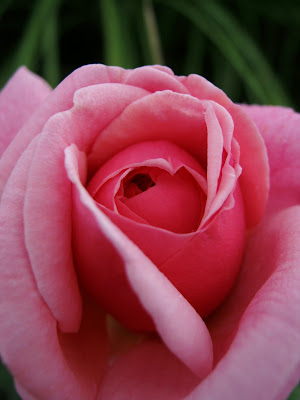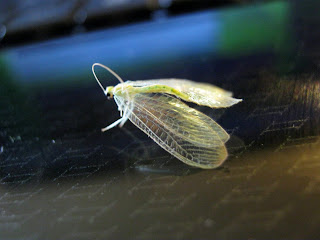I wish there a been a bit more wind so that I could get the full musical effect! It is in essence a giant wind-powered instrument.
There were a huge variety of summer flowers in bloom. I not usually a big fan of roses, but this one arrested my attention, and instantly brought to mind a famous Sherlock Holmes quote:
"What a lovely thing a rose is!...Its smell and its color are an embellishment of life, not a condition of it. It is only goodness which gives extras, and so I say again that we have much to hope from the flowers." - The Naval Treaty
As I approached the butterfly house, I was startled by the odd flying creatures who kept scattering before my step. It took me several minutes to realize that they were a type of grasshopper - I'd never before noticed how beautiful their wings are! I thought them a butterfly at first with their beautiful blue markings.
Entering the butterfly house is a bit strange. Instantly humid, and suddenly surrounded on all sides by some of the most vibrant and beautiful creatures in all stages of life who grace this planet. With the huge trees and few showy flowers or host plants that my yard offers, I often catch only a glimpse or two of Lepidoptera all summer, and here they were everywhere!
Black Swallowtail (Papilio polyxenes)
Pipevine Swallowtail (Battus philenor)
There were both host plants for the larvae and various flowers for the adults.
Black Swallowtail (Papilio polyxenes)
Black Swallowtail (Papilio polyxenes) eggs - and a larvae
I had great chat with some of the fantastic volunteers who educate the public and care for all the butterflies (I am now fiercely determined to volunteer there next summer!). The first of my worries was regarding OE - do need to bleach the milkweed leaves prior to feeding to remove any possible traces? The volunteers assured me that while it was indeed a matter of concern for them, with literally hundreds of insects confined in one area together, the 3 monarchs I have at home shouldn't be a high enough population density for me to worry about it. They showed me the cages they use to protect young caterpillars and suggested that I obtain a similar box. I'll have to visit a pet supply store before too long and see if I can't find something. One of the volunteers in particular spoke to me in some length about good host plants, and I think I'll take her advice next year. Parsley works well in pots, so she suggested that with the minimal sun my yard gets, a large clump moved into the sun for part of the day would work very well as a host for black swallowtails. I'm not sure whether pipevine will work or not, but I may need to try it as well just to see, since pipevine swallowtails are by far one of my favorites. As for milkweed, Asclepias incarnata would be a great option, since it grows from seed quite well and will not spread with the madness of other varieties. Spicebush is a much larger and more attractive shrub than I realized, so I'll have to look into obtaining one. I'm planning next spring to begin a small butterfly host plant garden in the center of my front yard. I've been trying to think of a better way to utilize the space, and perhaps this will be the perfect new spot for my insect obsession!
Spicebush Swallowtail (Papilio troilus)
The volunteers also took the time to teach me a bit about Ohio's silkworm moths. I had no idea what their cocoons look like, so it was great to see and compare them. I'll be on the lookout from now on.
Cecropia Moth (Hyalophora cecropia) cocoons
An empty black swallowtail cocoon on some Queen Anne's lace
I came home to my new monarch setup - the bay window, where they will be a little warmer and farther away from an air vent. The younger cats were in the latter phase of a first molt. I'd say all three are second instar now.
Size comparison - 4 and 6 days old.
I found an odd dead insect in a plant we bought at Cox. I haven't tried to ID it yet - if anyone recognizes it please leave a comment!
















The native butterfly house will only be open for another week this year, so be sure to visit!
ReplyDelete